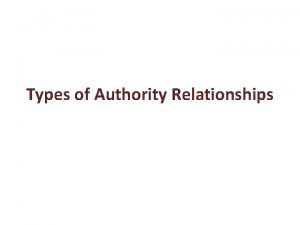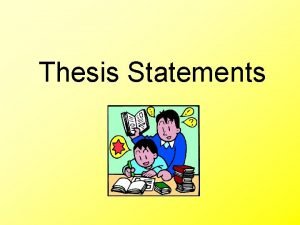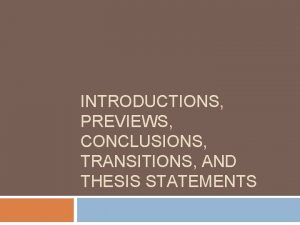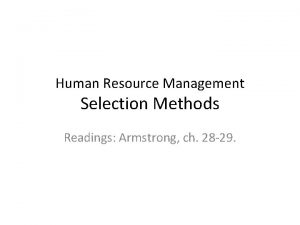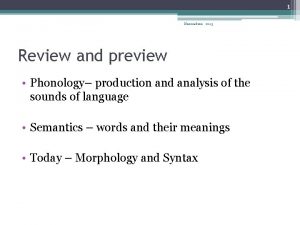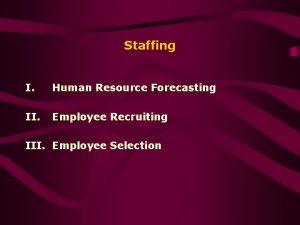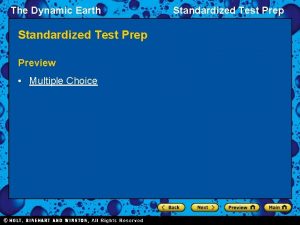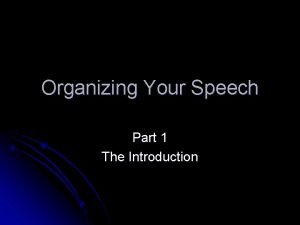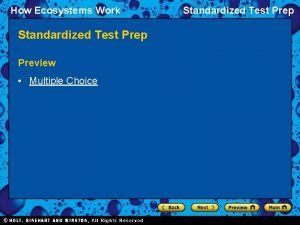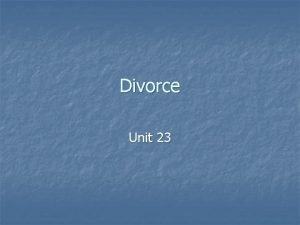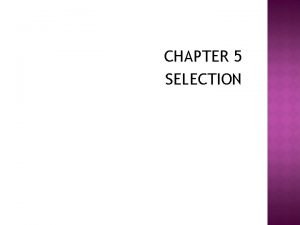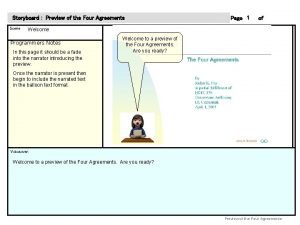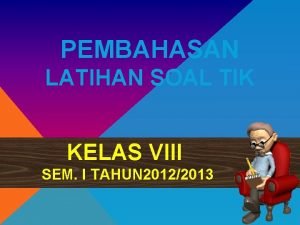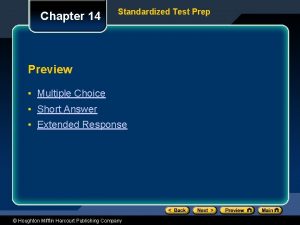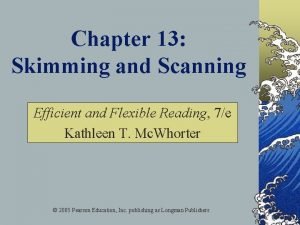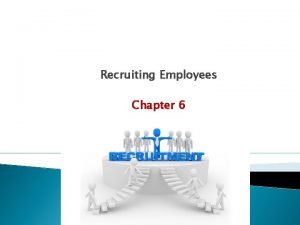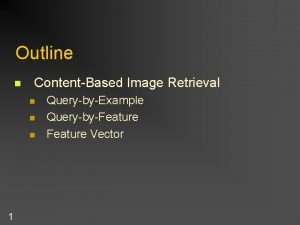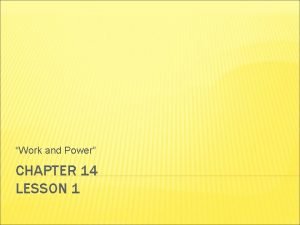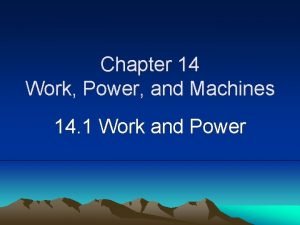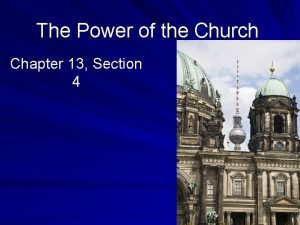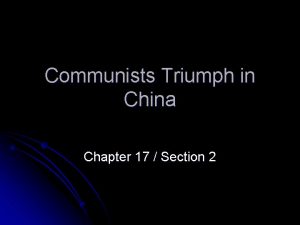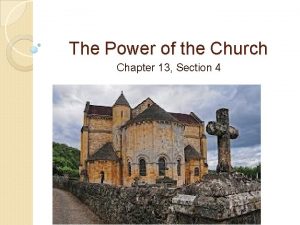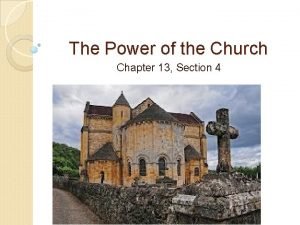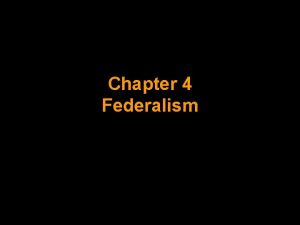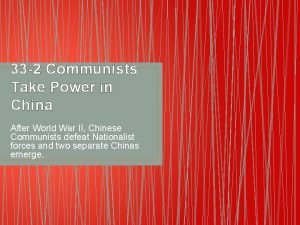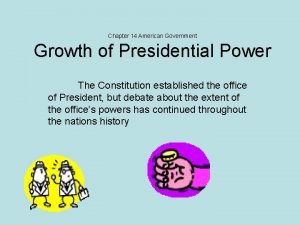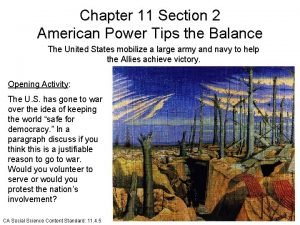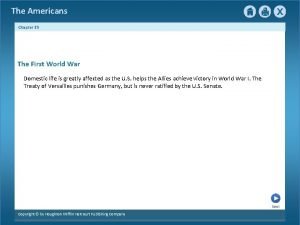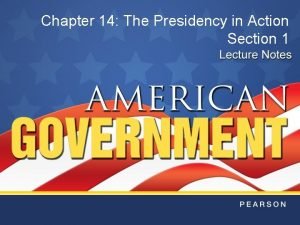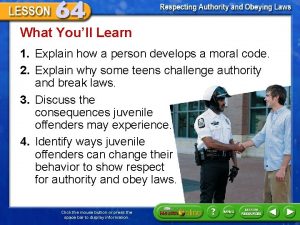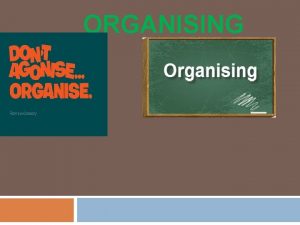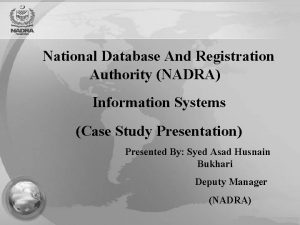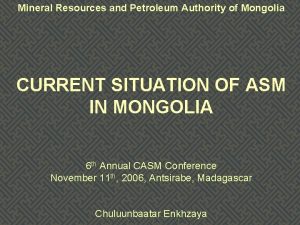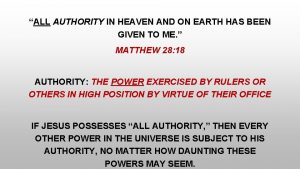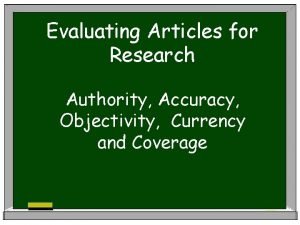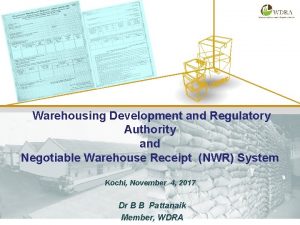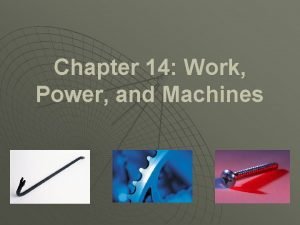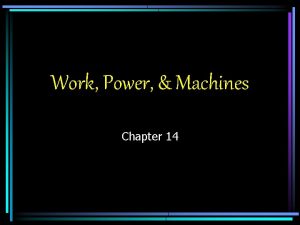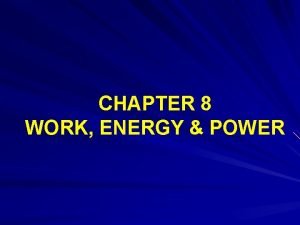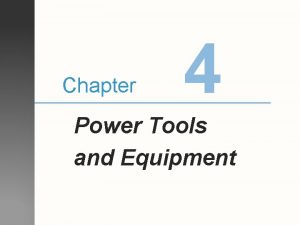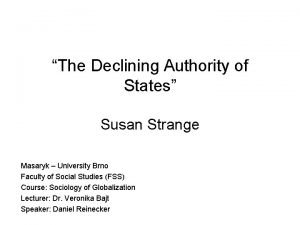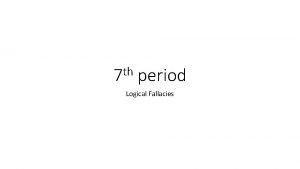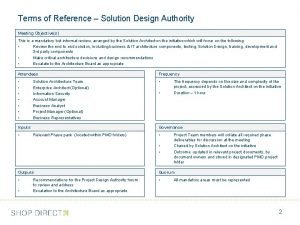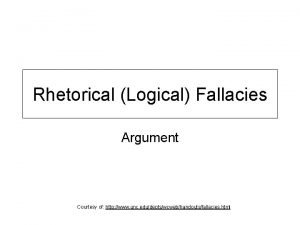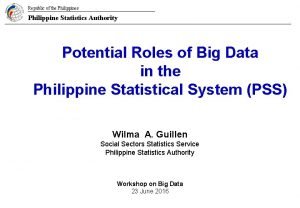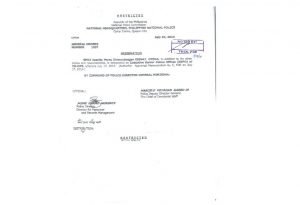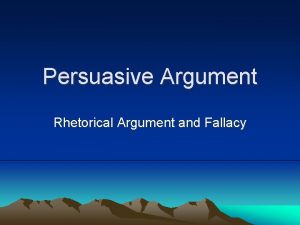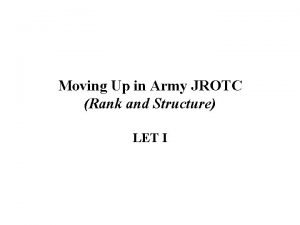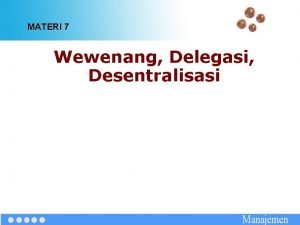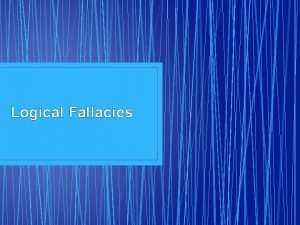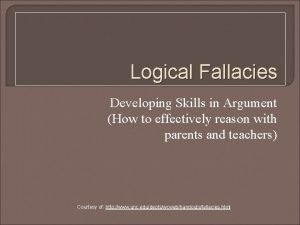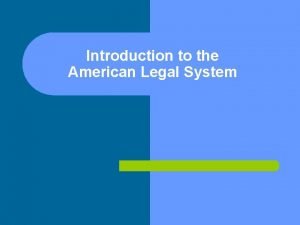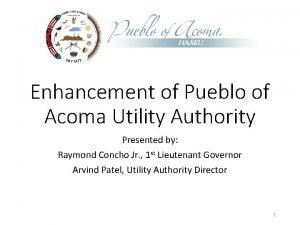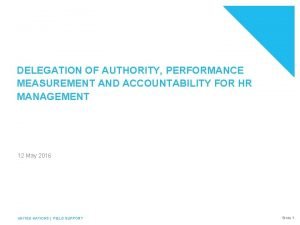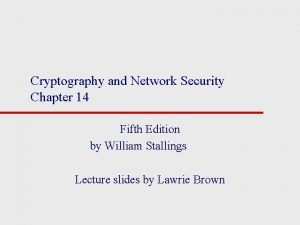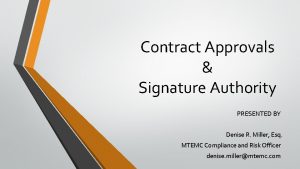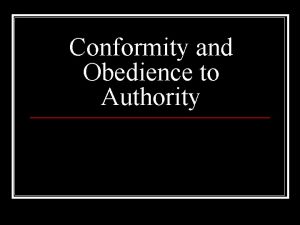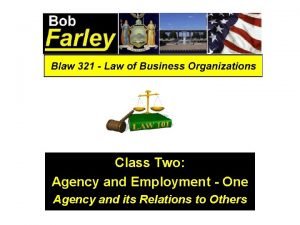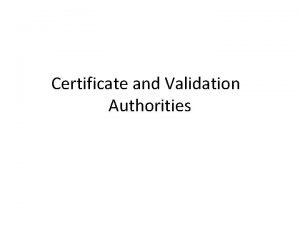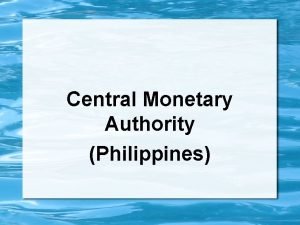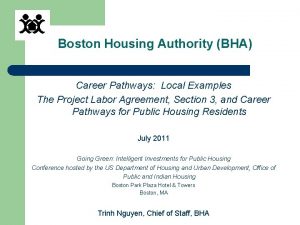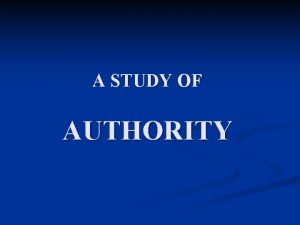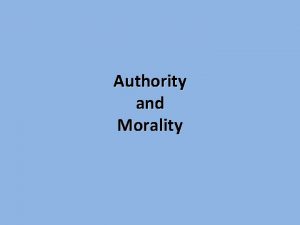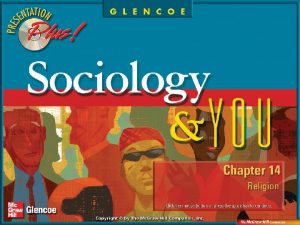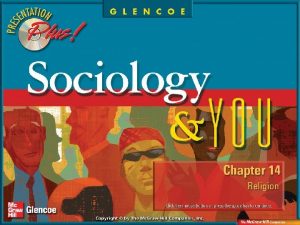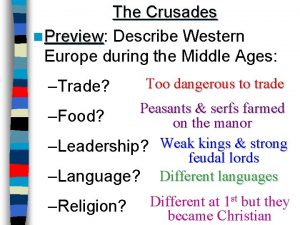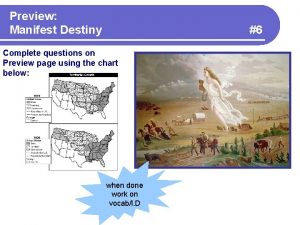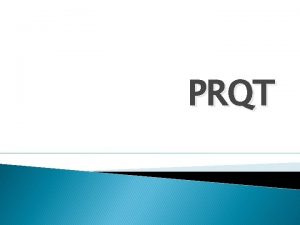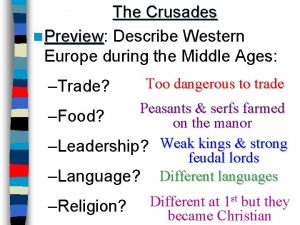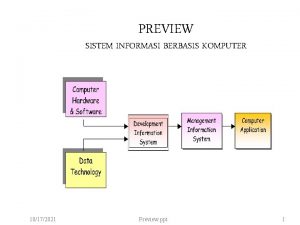Chapter Preview Section 1 Power and Authority Section






































































































































- Slides: 134


Chapter Preview Section 1: Power and Authority Section 2: Political Power in American Society Section 3: Economic Systems Section 4: The Modern Corporation Section 5: Work in the Modern Economy

Chapter Preview · Section 1 Power and Authority (pages 424– 432) Political systems can be based on three types of authority: charismatic, traditional, and rational-legal. Democratic, totalitarian, and authoritarian are types of political systems. In democracies, power lies with elected officials. Totalitarian systems have absolute rulers who control all aspects of political and social life. Authoritarian rules possess absolute control but often permit some personal freedoms.

Chapter Preview · Section 2 Political Power in American Society (pages 433– 439) The two major models of political power are elitism and pluralism. Advocates of the conflict perspective believe American society is controlled by elites. Pluralists, whose view is associated with functionalism, depict power as widely distributed among interest groups. Voting does not seem to be an effective means for nonelites to influence political decisions in the U. S.

Chapter Preview · Section 3 Economic Systems (pages 440– 445) Capitalist economics are based on private property and the pursuit of profit. In socialist economies, the means of production are owned collectively. Government has an active role in planning and controlling the economy.

Chapter Preview · Section 4 The Modern Corporation (pages 446– 449) Corporations affect domestic political decision making and influence the political and economic institutions of the countries around the world.

Chapter Preview · Section 5 Work in the Modern Economy (pages 450– 456) Workers today face a changing job structure. More corporations are downsizing and replacing full-time employees with consultants or temporary workers.


Authority is the sanctioned use of power. Political systems can be based on three types of authority: charismatic, traditional, and rational-legal. Democratic, totalitarian, and authoritarian are types of political systems. In democracies, power lies with elected officials. Totalitarian political systems have absolute rulers who control all aspects of political and social life. Authoritarian rulers possess absolute control but often permit some personal freedoms.

• economic institution • rational-legal authority • political institution • power • coercion • authority • charismatic authority • traditional authority • representative democracy • totalitarianism • authoritarianism

Which of the following are political systems? A. Democratic B. Totalitarian C. Authoritarian D. All of the above A. B. C. D. A B C D

Definitions of Power and Authority • The set of functions that concern the production and distribution of goods and services for a society is called the economic institution. • The responsibility for handling conflicts lies with the institution through which power is obtained and exercised—the political institution.

Definitions of Power and Authority (cont. ) • Politics and the economy are closely linked. – Power is the ability to control the behavior of others, even against their will. – Coercion is the use of physical force or threats to exert control. – Authority is power accepted as legitimate by those subject to it.

What is power and authority? A. The ability to control the behavior of others B. Control through force C. Power accepted as legitimate by those subject to it D. All of the above A. B. C. D. A B C D

Forms of Authority • Three types of leaders: – Charismatic authority—these leaders lead through the power or strength of their personalities or the feelings of trust they inspire in large numbers of people. – Traditional authority—the legitimacy of this leader is rooted in custom. – Rational-legal authority—power resides in the offices rather than in the officials.

What are three forms of authority? A. Charismatic B. Traditional C. Rational-legal D. All of the above A. B. C. D. A B C D

Types of Political Systems • Political systems have evolved over time, finally boiling down into democratic, totalitarian, and authoritarian forms.

In hunting and gathering societies, political leaders were chosen on the basis of which of the following? A. Their family line B. Exceptional physical prowess C. Personal charisma D. None of the above A. B. C. D. A B C D

Democracy • In a representative democracy, elected officials are responsible for fulfilling the wishes of the majority of the citizens. • Two-party versus three-party system

Democracy (cont. ) • Two assumptions: – Not everyone in modern society can be actively involved in all political decision making. – Political candidates who fail to satisfy the wishes of the majority are not expected to win reelections. Political Freedom

Which party system do you favor? A. Two-party B. Three-party C. Winner take all D. All of the above A. B. C. D. A B C D

Totalitarianism • Totalitarianism—a ruler with absolute power attempts to control all aspects of a society. • Characteristics: – A single political party, typically controlled by one person – A well-coordinated campaign of terror

Totalitarianism (cont. ) – Total control of all means of communication – A monopoly over military resources – A planned economy directed by a state bureaucracy The Political Continuum

Characteristics of totalitarian states include which of the following: A. A single political party typically controlled by one person B. A well-coordinated campaign of terror A. C. A monopoly over B. military resources C. D. Total control of all D. means of communication A B C D

Authoritarianism • Authoritarianism refers to a political system controlled by elected or nonelected rulers who usually permit some degree of individual freedom but do not allow popular participation in government.

How does authoritarianism differ from totalitarianism? A. Citizens can participate in government. B. There is some degree of individual freedom. C. It utilizes a campaign of terror. D. None of the above A. B. C. D. A B C D


The two major models of political power are elitism and pluralism. Advocates of the conflict perspective believe American society is controlled by elites. Pluralists, whose view is associated with functionalism, depict power as widely distributed among interest groups. Voting does not seem to be an effective means for nonelites to influence political decisions in the U. S.

• political socialization • pluralism • elitism • interest group • power elite

How much influence do you think the political power has in the hands of the elite or distributed among different groups? A. Much influence B. Some influence C. Little influence D. No influence A. B. C. D. A B C D

Influence of the Vote • In practice, the amount of real choice exercised through voting is limited due to restricted candidate choices. • Political socialization involves the informal and formal processes by which a person develops political opinions.

Influence of the Vote (cont. ) • Informal agents of socialization: – The family – Education – Mass media – Economic status and occupation – Age and gender

Influence of the Vote (cont. ) • The U. S. has one of the lowest voter turnout rates in the industrialized world (58% in 2004). Voter Participation in Presidential Elections: 1932– 2004

Influence of the Vote (cont. ) • Reasons: – Low level of confidence in political leaders. – Political parties are no longer instrumental in getting voters to the polls. Voter Turnout

What are some of the reasons voter turnout is so low? A. Relatively low level of confidence in political leaders B. Political parties are no longer as instrumental in getting voters to the polls C. People with little education D. People with smaller incomes A. B. C. D. A B C D

Two Models of Political Power • Two major models of political power: – Pluralism—political decisions are the result of bargaining and compromise among special interest groups. – Elitism—a community or society is controlled from the top by a few individuals or organizations. Characteristics of Two Models of Political Power

Which of the following are Pluralist and Power Elite perspectives? A. Resources of interest groups B. Concentrated in hands of elites C. Spread widely among interest groups D. Preferences of the elites A. B. C. D. A B C D

Functionalist Perspective: Pluralism • According to pluralists, major political decisions are not made by an elite few. • An interest group is a group organized to influence political decision making. • Pluralists believe that decisions are made as a result of competition among special interest groups, each of which has its own stake in the issues. Types of Interest Groups

Would you consider interest groups to be a positive or negative aspect of politics? A. Positive B. Negative A. A B. B

Conflict Perspective: The Power Elite • The power elite consist of key people in each area (economic, political, and military) who overlap to form a unified group in order to gain what they want politically.

What common interests do members of the power elite share? A. Similar social backgrounds B. Economic backgrounds C. Upper-class families D. Belong to Episcopalian and Presbyterian churches A. B. C. D. A B C D


Capitalist economies are based on private property and the pursuit of profit, and government, in theory, plays a minor role in regulating industry. In socialist economies, the means of production are owned collectively, and government has an active role in planning and controlling the economy.

• capitalism • monopolies • oligopolies • socialism

What are the basic premises of capitalism? A. The sanctity of private property B. The right of individuals to profit from their labors C. The pursuit of profit D. All of the above A. B. C. D. A B C D

Capitalism • Capitalism is an economic system founded on two basic premises: – the sanctity of private property – the rights of individuals to profit from their labors

Capitalism (cont. ) • No pure capitalist society exists. • Deviations include: – Monopolies—companies that control a particular market. – Oligopolies—combinations of companies working together to control a market. Examples of Government Economic and Regulatory Assistance

Despite its shortcomings, do you feel that capitalism is a good economic system? A. Very much so B. Somewhat C. Not at all A. A B. B C. C

The Role of Government in Capitalism • The Constitution provides a role for the government in the promotion of a sound economy. • The government is responsible for the: – regulation of commerce – development of a strong currency – creation of uniform standards for commerce – provision of a stable system of credit

How strongly do you feel the government does a good job promoting a sound economy? A. Very strongly B. Somewhat strongly C. Not very strongly D. Not strongly at all A. B. C. D. A B C D

Socialism • Socialism is an economic system founded on the belief that the means of production should be controlled by the people as a whole. • The state should own and control property.

Socialism (cont. ) • Workers should be able to exert significant control over both their work organizations and the policy directions of the society as a whole. • Pure socialism does not exist.

Which is the best reason why a purely socialist economy does not exist? A. Workers receive wages below the value their labor produces. B. Workers have little control over their work. C. Both the state and workplace exist for the worker’s benefit D. The workers exert significant control. A. B. C. D. A B C D

Mixed Economic Systems • Most nations fall between the extremes of capitalism and socialism and include elements of both economic systems.

Do you feel that mixing both systems is beneficial? A. Very much so B. Somewhat C. Not very much D. Not at all A. B. C. D. A B C D


Corporations, especially those with multinational connections, have grown very powerful. Corporate mangers affect domestic political decision making and influence the political and economic institutions of countries around the world.

• corporation • interlocking directorates • conglomerates • multinationals

Does the following come to mind when you think of a corporation? A. An organization owned by shareholders B. Have limited liability and limited control C. Cannot be held financially responsible for actions A. A B. B C. C

The Nature of Corporations • A corporation is an organization owned by shareholders who have limited liability and limited control. • The real control rests with the board of directors and management.

Do you agree with the following statement: “U. S. corporations influence the economies of nations around the world? ” A. Very much B. Somewhat C. Not very much D. Not at all A. B. C. D. A B C D

Corporate Influence • Top corporate officials have tremendous influence on government decisions. • Reasons: – They can reward or punish elected government officials through investment decisions.

Corporate Influence (cont. ) – Interlocking directorates—directorates that result when heads of corporations sit on one another’s boards. – Conglomerates—networks of unrelated businesses operating under a single corporate umbrella.

Do you feel that it is positive or negative that businesses have so much influence on government decisions? A. Positive B. Negative A. A B. B

Multinational Corporations • Multinationals are firms based in highly industrialized societies with operating facilities throughout the world. • Corporations provide developing countries with: – technology – capital – foreign markets – products Total Revenue of Multinational Corporations versus National Gross Domestic Products

Multinational Corporations (cont. ) • Multinationals harm the economies of foreign countries by: – exploiting natural resources – disrupting local economies – introducing inappropriate technologies and products – increasing the amount of income inequality

Do you feel that multinationals are beneficial or harmful? A. Beneficial B. Harmful A. A B. B


Workers today face a changing job structure. More corporations are downsizing and replacing full-time employees with consultants or temporary workers. Evidence indicates that this trend is having some negative consequences.

• primary sector • core tier • secondary sector • peripheral tier • tertiary sector • downsizing • occupations • contingent employment

What are some reasons companies are downsizing? A. Contingent employment B. Work can be done by fewer employees C. Lower profits caused by increasing foreign competition A. A B. B C. C

The Changing Nature of Work • Primary sector—this sector depends on the natural environment to produce economic goods. • Secondary sector—this sector includes factory workers of all types (blue collar workers). • Tertiary sector—these employees provide services (white collar workers). Distribution of Workers by Occupational Category

Do you feel that the economy will continue to demand tertiary workers? A. Very much so B. Somewhat C. Not very much D. Not at all A. A B. B C. C D. D

Occupational Structure • Occupations are categories of jobs that involve similar activities at different work locations.

Occupational Structure (cont. ) • A two-tier occupational structure has developed in the U. S. : – Core tier—jobs with large firms who pay more, offer better benefits and provide longer-term employment. – Peripheral tier—jobs in smaller firms that have low pay, little or no benefits, and short-term employment.

Occupational Structure (cont. ) • Good news: – The U. S. economy continues its healthy growth and unemployment remains low. • Bad news: – The new jobs are not as good, or do not require the same skill-set, as the manufacturing jobs they are replacing.

Occupational Structure (cont. ) – Reemployment of laid-off workers is a problem. – The U. S. economy has been losing higher-paying jobs and gaining lowerpaying jobs, also known as downwaging.

What reasons do you feel the American dream is being threatened? A. Job loss B. Downwaging trends C. Downsizing D. Contingent employment A. A B. B C. C D. D

Downsizing and Contingent Employment • These two strategies reduce employment in core industries: – Downsizing—the process by which companies reduce the size of their fulltime workforce. – Contingent employment involves hiring people on a part-time or short-term basis. Evidence of Declining Trust in Management

How strongly do you feel about the following statement: “Technology should replace people? ” A. Very strongly B. Somewhat strongly C. Not very strongly D. Not strongly at all A. A B. B C. C D. D


The Political Continuum

Voter Participation in Presidential Elections: 1932– 2004 Source: U. S. Bureau of the Census, Statistical Abstract of the United States, 2004– 2005 and Current Population Survey (November 2004).





Total Revenue of Multinational Corporations versus National Gross Domestic Products Source: The World Almanac Book of Facts, 2005.

Distribution of Workers by Occupational Category Source: U. S. Department of Labor, Bureau of Labor Statistics, 2004.

Evidence of Declining Trust in Management Source: The 2003 Towers Perrin Talent Report( Boston, MA), 2003.

Voter Turnout Source: U. S. Bureau of the Census, Current Population Survey (November 2004).

Political Freedom Source: Freedom House, Washington, D. C. , 2005.

Sociology Chapter Transparencies Heights of American Presidents Who Have Served in War Religious Preferences of Presidents Profile of the American Voter How Much Responsibility Should the Government Take for… Occupation by Race and Ethnicity (African American and Latino) Occupations with the Largest Expected Growth








economic institution that determines how goods and services are produced and distributed

political institution that determines how power is obtained and exercised

power the ability to control the behavior of others

coercion control through force

authority power accepted as legitimate by those subject to it

charismatic authority that arises from the personality of an individual

traditional authority form of authority in which the legitimacy of a leader is rooted in custom

rational-legal authority form of authority in which the power of government officials is based on the offices they hold

representative democracy a system of government that uses elected officials to fulfill majority wishes

totalitarianism a political system in which a ruler with absolute power attempts to control all aspects of a society

authoritarianism a political system controlled by elected or nonelected rulers who usually permit some degree of individual freedom

political socialization informal and formal processes by which a person develops political opinions

pluralism system in which political decisions are made as a result of bargaining and compromise among special interest groups

elitism system in which a community or society is controlled from the top by a few individuals or organizations

interest group a group organized to influence political decision making

power elite a unified group of military, corporate, and government leaders

capitalism an economic system based on private ownership of property and the pursuit of profit

monopolies companies that have control over the production or distribution of a product or service

oligopolies combinations of companies that control the production or distribution of a product or service

socialism an economic system founded on the belief that the means of production should be controlled by the people as a whole

corporation an organization owned by shareholders, who have limited liability and limited control

interlocking directorates that result when heads of corporations sit on one another’s boards

conglomerates networks of unrelated businesses operating under one corporate umbrella

multinationals firms based in highly industrialized societies with operating facilities throughout the world

primary sector that part of the economy producing goods from the natural environment

secondary sector that part of the economy engaged in manufacturing goods

tertiary sector that part of the economy providing services

occupations categories of jobs that involve similar activities at different work locations

core tier an occupational structure composed of large firms dominating their industries

peripheral tier an occupational structure composed of smaller, less profitable firms

downsizing the process by which companies reduce their workforces

contingent employment the hiring of part-time, short-term workers

To use this Presentation Plus! product: Click the Forward button to go to the next slide. Click the Previous button to return to the previous slide. Click the Home button to return to the Chapter Menu. Click the Transparency button to access the transparencies that are relevant to this chapter. Click the Return button in a feature to return to the main presentation. Click the Sociology Online button to access online textbook features. Click the Exit button or press the Escape key [Esc] to end the chapter slide show. Click the Help button to access this screen. Links to Presentation Plus! features such as the Figures, Time Lines, Snapshot of America, World View and others are located at the bottom of relevant screens.

 What is a line authority
What is a line authority Nhd thesis statement
Nhd thesis statement Summary thesis statement
Summary thesis statement Thesis and preview statement example
Thesis and preview statement example Realistic job preview advantages and disadvantages
Realistic job preview advantages and disadvantages Review and preview
Review and preview Benefits of hr forecasting
Benefits of hr forecasting Power triangle
Power triangle Difference between authority and power
Difference between authority and power Prayer of authority
Prayer of authority Difference between authority and power
Difference between authority and power Test prep preview
Test prep preview Test prep preview
Test prep preview Test prep preview
Test prep preview Test prep preview
Test prep preview Sccm technical preview
Sccm technical preview Preview statement speech example
Preview statement speech example Test prep preview
Test prep preview Nnn preview
Nnn preview The selection preview
The selection preview Chapter 21 standardized test practice answers
Chapter 21 standardized test practice answers The four agreements preview
The four agreements preview Test prep preview
Test prep preview Perintah print preview kita jalankan dari menu
Perintah print preview kita jalankan dari menu Test prep preview
Test prep preview Skimming newspaper
Skimming newspaper 1984 book preview
1984 book preview Yandex.ru films
Yandex.ru films Nút lệnh print preview nằm ở đâu
Nút lệnh print preview nằm ở đâu Tams college acceptance
Tams college acceptance Disadvantages of realistic job preview
Disadvantages of realistic job preview Multi-channeled definition in communication
Multi-channeled definition in communication Preview speech
Preview speech Verbal intercultural communication examples
Verbal intercultural communication examples Nnn image preview
Nnn image preview Fungsi movie task pane
Fungsi movie task pane Chapter 14 section 1 work and power
Chapter 14 section 1 work and power Chapter 14 section 1 work and power
Chapter 14 section 1 work and power Chapter 13 section 4 the power of the church
Chapter 13 section 4 the power of the church Chapter 17 section 2 communists take power in china
Chapter 17 section 2 communists take power in china Chapter 17 section 2 communists take power in china
Chapter 17 section 2 communists take power in china Otto invades italy on pope's behalf causes and outcomes
Otto invades italy on pope's behalf causes and outcomes Causes of otto invades italy on pope's behalf
Causes of otto invades italy on pope's behalf Federalism the division of power chapter 4 section 1
Federalism the division of power chapter 4 section 1 Chapter 33 section 2 communists take power in china
Chapter 33 section 2 communists take power in china Chapter 14 section 1 the growth of presidential power
Chapter 14 section 1 the growth of presidential power American power tips the balance
American power tips the balance Chapter 19 the americans
Chapter 19 the americans Chapter 14 the presidency in action
Chapter 14 the presidency in action Solar power satellites and microwave power transmission
Solar power satellites and microwave power transmission Actual power
Actual power Dispersive power of plane diffraction grating
Dispersive power of plane diffraction grating Chapter 10 section 1: meiosis
Chapter 10 section 1: meiosis Flex power power supply
Flex power power supply Power of a power property
Power of a power property General power rule vs power rule
General power rule vs power rule Power angle curve in power system stability
Power angle curve in power system stability Powerbi in powerpoint
Powerbi in powerpoint Power delivered vs power absorbed
Power delivered vs power absorbed Why do some youth challenge authority and break laws
Why do some youth challenge authority and break laws Difference between accountability and responsibility
Difference between accountability and responsibility Nadra complaint management system
Nadra complaint management system Mineral resources and petroleum authority of mongolia
Mineral resources and petroleum authority of mongolia Managerial functions
Managerial functions National authority for remote sensing and space sciences
National authority for remote sensing and space sciences All authority in heaven and earth
All authority in heaven and earth Tea directorate
Tea directorate Emirates authority for standardization and metrology
Emirates authority for standardization and metrology Accuracy authority objectivity currency and coverage
Accuracy authority objectivity currency and coverage Warehousing development and regulatory authority
Warehousing development and regulatory authority Zanzibar stone town heritage society
Zanzibar stone town heritage society Public authority for electricity and water
Public authority for electricity and water Oil and gas free zone authority recruitment
Oil and gas free zone authority recruitment Websams sql
Websams sql Tea directorate
Tea directorate Category 5 and 6 local authority districts
Category 5 and 6 local authority districts Chapter 14 work power and machines
Chapter 14 work power and machines Chapter 14 work power and machines
Chapter 14 work power and machines Chapter 8 work and power answers
Chapter 8 work and power answers Chapter 10 power tools and shop equipment
Chapter 10 power tools and shop equipment Section 4 review physical science
Section 4 review physical science Half section view vs full section view
Half section view vs full section view What is the definition of chemical potential energy
What is the definition of chemical potential energy Lenawee county cmh
Lenawee county cmh University of massachusetts building authority
University of massachusetts building authority Saskatchewan health authority philippines
Saskatchewan health authority philippines The declining authority of states
The declining authority of states False authority in the crucible
False authority in the crucible Authority fallacy examples
Authority fallacy examples Design authority terms of reference
Design authority terms of reference Formal authority teaching style
Formal authority teaching style Fdot tampa hillsborough expressway authority
Fdot tampa hillsborough expressway authority Pd&r
Pd&r What is source of authority
What is source of authority Indonesian professional certification authority
Indonesian professional certification authority Steven memberg
Steven memberg Appeal to ignorance
Appeal to ignorance Philippine statistics authority
Philippine statistics authority Port arthur housing authority
Port arthur housing authority Pnp organization structure
Pnp organization structure Argument from authority
Argument from authority Ethos pathos logos in fahrenheit 451
Ethos pathos logos in fahrenheit 451 State authority occupational crime
State authority occupational crime All evil begins with 15 volts
All evil begins with 15 volts In the pyramid of authority in jrotc
In the pyramid of authority in jrotc Contoh authority dalam organisasi
Contoh authority dalam organisasi International plaza lorain ohio
International plaza lorain ohio Begging the question
Begging the question Ad hominem
Ad hominem Panchgram development authority
Panchgram development authority Jabalpur development authority
Jabalpur development authority Bpo barangay
Bpo barangay Secondary authority
Secondary authority Hrpa membership
Hrpa membership Ted k center plattsburgh ny
Ted k center plattsburgh ny Pueblo of acoma utility authority
Pueblo of acoma utility authority Western health pharmacy
Western health pharmacy 5 roles of an nco
5 roles of an nco Delegation of authority framework
Delegation of authority framework Cuyahoga county housing authority
Cuyahoga county housing authority Certificate authority (ca) vs key distribution centre (kdc)
Certificate authority (ca) vs key distribution centre (kdc) Sample corporate signature authority policy
Sample corporate signature authority policy Authority conformity
Authority conformity Conformity to authority
Conformity to authority Commonwealth health insurance connector authority
Commonwealth health insurance connector authority One two agency
One two agency Upper colorado river authority
Upper colorado river authority Lord of the flies chapter 8
Lord of the flies chapter 8 Secondary authority
Secondary authority Validation authority
Validation authority Central monetary authority
Central monetary authority Cape coral charter school authority
Cape coral charter school authority Single issuing authority
Single issuing authority Camtran route 17
Camtran route 17 Boston housing authority
Boston housing authority
